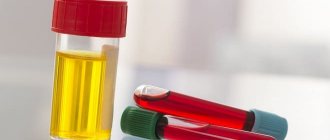There is much controversy in diagnosing diabetes based on blood glucose levels. They are due to the fact that this indicator depends on many external factors, primarily on the correct preparation for the examination. Using an analysis for glycated, or glycosylated, hemoglobin, the norms of which are practically independent of the test conditions, you can correctly diagnose diabetes mellitus with almost 100% confidence.
What is glycosylated hemoglobin
Keeping your blood sugar under control is not easy, and many methods often give incorrect results. One of the most accessible and effective options is an analysis for glycosylated hemoglobin. This test is more reliable than blood glucose.
Glycosylated hemoglobin is a compound that determines the average blood sugar value over the last 120 days. Instead of the word "glycosylated" you can use "glycosylated". These adjectives are synonymous and both refer to hemoglobin, which is related to glucose.
For healthy people and people with diabetes, an increase in the amount of glycohemoglobin in the blood is a reason to go to the hospital. The doctor will prescribe a course of therapy or advise you to work on lifestyle changes. To prevent the disease, they offer a special diet, subject to which you need to eat only foods that contain a small amount of carbohydrates.
The method of checking sugar levels by determining glycosylated hemoglobin turns out to be quite effective. However, it still has one drawback: its effectiveness decreases if any manipulations are carried out with the blood.
For example:
- if the patient participated in a blood transfusion, the glycohemoglobin levels of the donor and the one to whom the blood was transferred will become different;
- a false decrease in results occurs after bleeding and hemolysis;
- a false increase can inevitably be observed in iron deficiency anemia.
Checking glycohemoglobin will help in case of:
- if the person being tested has a sugar level on the very edge of normal;
- when the patient does not follow a diet for 3-4 months, and a week before the study he stopped consuming harmful carbohydrates, hoping that no one will know about it.
Once diagnosed, you should consult a doctor. The specialist will tell you how often you should check for therapy control. If the patient does not complain about anything, the doctor prescribes the dates of visits to the endocrinologist’s office. The lifespan of red blood cells determines the frequency of testing for glycohemoglobin. This must be done every 120 days.
If there are no complaints or negative dynamics, then there is no point in visiting the doctor more often.
Norm
| Category | Description |
| For adults | The norm is considered to be a glycohemoglobin content of 5%. Deviations in any direction of 1% can be considered insignificant. Target values depend on age and the nuances of the course of the disease. For example:
However, it makes sense to talk about such figures if patients do not have complications and there is no risk of severe hypoglycemia. In another case, the indicator should increase by 0.5% for each category. It is not the patient himself who determines the result. The test should be carried out simultaneously with glycemic analysis. The average value of glycohemoglobin and its norm do not guarantee that the level will not change dramatically during the day. |
| For pregnant | The level of glycohemoglobin in these women may differ significantly from the norm, because the mother’s body works for itself and the child. The following indicators are considered the norm:
If a pregnant woman has a glycohemoglobin level of 8-10%, this indicates a complication and requires therapy. The expectant mother must undergo a sugar test several times throughout her pregnancy, having eaten before the procedure itself. |
| For children | The norm of glycohemoglobin in children is equal to adults and is 5-6%. The only difference is in containing the high rate. If it is knocked down sharply, the baby may experience vision problems. It should be remembered: the child’s body is not yet strong enough and therefore needs a special approach. |
| For people with diabetes | Once a diagnosis is made, the patient’s main goal is to keep the rate within 7%. This is not easy and the patient has to take many features into account. To accomplish the task of curbing the rise in sugar levels, the following are used:
|
The nuances of glucose control in women during pregnancy
Despite the advantages of testing for glycohemoglobin, it is better not to do it for pregnant women, because the problem of increased blood glucose often arises after the 6th month. The same analysis will only show an increase after 2 months, which is already close to the birth itself, and if the indicators are too high, measures to reduce them will no longer be effective.
If you donate blood in the morning and on an empty stomach, the result will be useless: the glucose level becomes higher after eating, and after 3-4 hours its high levels can harm the mother’s health. At the same time, it is imperative to keep your blood sugar under control.
The most informative test will be a blood sugar test done at home. Having purchased an analyzer, you can carry out the test at home half an hour, 1 and 2 hours after eating. The level should not be higher than 7.9 mmol/l; when it is higher, it requires contacting a doctor.
Reasons for deviation of the indicator from the norm
The ideal level of glycohemoglobin is in the range of 4.6-5.7% .
This HBA1C value does not allow the glucose level to exceed the permissible values, which indicates the presence of a minimal risk of the formation of any pathologies. Anyone should take steps to achieve optimal levels.
True, sometimes situations arise when the deviations presented below are observed. When glycated hemoglobin increases over a long period of time, the patient is usually diagnosed with diabetes.
This serious illness requires the initiation of an immediate course of therapy in compliance with the prescribed diet.
But sometimes a slightly increased glycohemoglobin can appear due to:
- lack of iron;
- excessive consumption of alcoholic beverages over a long period of time;
- renal failure;
- poisoning of the body with substances of a chemical nature;
- surgery leading to the removal of the spleen.
In turn, low values of glycohemoglobin density usually appear when:
- blood transfusion;
- blood loss as a result of injury, surgery, abortion, difficult childbirth;
- hemolytic disease.
A course of therapeutic support helps here, which after a short time normalizes the value of glycated hemoglobin.
Deviations from standard glycohemoglobin levels are also sometimes observed, which is explained by a lack of iron in the body.
Indications for the study
Glycosylated hemoglobin is a compound whose level should be constantly monitored.
Indications for the study are:
- diabetes screening and diagnosis;
- monitoring long-term control of hyperglycemia in people with diabetes;
- determining the level of diabetes compensation;
- impaired glucose tolerance;
- examination of pregnant women.
A glycohemoglobin test should be performed if the following symptoms of diabetes occur:
- dry mouth;
- nausea;
- causeless weight loss;
- weaknesses;
- excessive fatigue;
- feelings of constant thirst or hunger;
- the urge to empty the bladder too often;
- wound healing takes too long;
- skin diseases;
- blurred vision;
- tingling in the arms and legs.
Indicators for diabetes mellitus
Biomaterial for the determination of glycated hemoglobin is taken upon diagnosis, or if the woman is aware that she is sick. Objectives of the study:
- Determining the degree of glucose presence in the blood.
- Adjusting the amount of use of glucose-lowering drugs.
Advantages compared to conventional sugar testing
A blood test for glycohemoglobin has many advantages over the traditional method of determining sugar levels based on the use of a glucometer:
- Speed of execution.
- Possibility of delivery at any time of the day and regardless of meals.
- High accuracy. This test allows you to accurately determine whether a patient has diabetes. Moreover, the disease can be detected much earlier than with a traditional blood test performed before eating food.
- Independence of indicators. The doctor, regardless of training, can always determine whether the patient has monitored his sugar levels in the last 3 months.
Advantages and disadvantages of the study
Each method has its pros and cons. The most significant advantage of this analysis is monitoring the sugar levels of patients who do not adhere to their diet or do not take medications regularly. Some people try to outwit their doctor by starting to reduce their sugar intake just a week before donating blood, but the truth still emerges, because glycated hemoglobin shows the average glucose value over the previous few months.
Advantages:
- DM is detected even in the early stages;
- you can monitor adherence to treatment and diet for the last 3 months;
- blood is donated from a finger or vein;
- analysis is carried out at any time of the day;
- based on the results, the possible risks of complications of diabetes are assessed;
- the results are not affected by infectious diseases.
Disadvantages include the cost of analysis. Also, it is not advisable to carry out analysis in all cases, since the results may be distorted. The study produces erroneous results in the following cases:
- Blood transfusion. This manipulation can interfere with identifying the true HbA1c level, because the donor’s indicators differ from those of the person who received someone else’s blood.
- Extensive bleeding.
- Blood diseases, such as iron deficiency anemia.
- Previously removed spleen.
- Liver and kidney diseases.
- Reduced levels of thyroid hormones.
Also, in some cases, you can get false readings if a person has high cholesterol or takes large amounts of vitamins E and C.
How to properly prepare for analysis
One of the main advantages of the glycohemoglobin test is the lack of special preparation.
The result coefficient is independent of:
- psycho-emotional state;
- physical activity;
- taking medications, including antibiotics;
- colds and infections;
- eating food and the period before or after it;
All preparation for the process consists of a moral attitude and obtaining a referral from a doctor if necessary.
How to get tested
WHO states that the level of glycohemoglobin in the blood is an important criterion according to which the diagnosis of diabetes mellitus is established. This diagnostic method is used to control a disease that was detected earlier.
The glycosylated hemoglobin indicator helps to assess the effectiveness of therapy and, if necessary, change the dosage of oral medications intended to reduce sugar. After all, it is very important to compensate for diabetes mellitus: it reduces the risk of complications.
If the patient is not sure that the test was done accurately, then he should consult with his doctor about how to take the test correctly. It is possible that there are individual characteristics. The doctor can easily identify them, taking into account the patient’s medical history.
The ability to determine glycated hemoglobin has appeared recently, so in some small towns this analysis still cannot be carried out. Consequently, diabetes control becomes difficult for residents of these cities.
Normal values for pregnant women
While carrying a child, the female body experiences many transformations.
Including the amount of glucose. Therefore, normal indicators during pregnancy for a woman are somewhat different:
- at a young age it is based around 6.5%.
- for middle-aged women the figure is 7%.
- for “older” pregnant women, the value must be at least 7.5%.
Glycated hemoglobin, the norm for women when carrying a child, should be monitored every 1.5 months. Because it is from this study that it becomes clear how the unborn child develops and grows. Deviations have a bad effect on the condition of not only the baby, but also the mother:
- An indicator below the standards indicates iron deficiency, and can cause fetal development to stop. There is an urgent need to change your lifestyle by consuming more seasonal fruits and vegetables.
- A high level of “sugar” hemoglobin indicates that the child is likely to be large (from 4 kg). This means that the natural physiological process that completes pregnancy will not be easy.
In general, the initial analysis does not require much preparation. To carry out the study, you just need to donate blood from a vein on the inner bend of your elbow or finger.
You can also perform a blood test for glycated hemoglobin at home. Portable glucometers are currently available for sale.
Interpretation of results
Glycosylated hemoglobin is a compound whose values correspond to the average blood sugar levels over a 3-month period.
Correspondence of indicators and diagnosis based on them can be as follows:
| Glycohemoglobin (%) | Blood glucose (mmol/l) | Impact on diagnosis |
| 4 | 3,8 | This means that carbohydrate metabolism is normal and the risk of diabetes is very low. |
| 4,5 | 4,6 | The risk of diabetes is minimal. |
| 5 | 5,4 | |
| 5,6 | 6,5 | |
| until 6 | close to 7 | The patient has a high risk of diabetes, which means he should eat less sweets and consult an endocrinologist. |
| 6,4 | < 7,5 | This is also a high indicator, and the patient needs to take measures to reduce it, be sure to exclude foods containing a lot of sugar from the diet. You should also consult a specialist. |
| above 6.5 | < 8 | The doctor diagnoses diabetes mellitus only preliminary: to confirm or refute it, some more tests should be taken. |
Glycosylated hemoglobin norm and deviations
In people with diabetes, the level of glycosylated hemoglobin can be several times higher than normal, for example, the indicator is:
| Glycohemoglobin (%) | Blood glucose (mmol/l) |
| < 8 | < 10 |
| 10 | 13,7 |
| 12 | 17,4 |
| 15 | 23 |
What to do and how to treat?
First of all, you need to contact your treating endocrinologist or therapist, who will give appropriate recommendations for lowering blood glucose levels.
Typically these include:
- compliance with nutrition and diet;
- maintaining sleep and wakefulness, preventing overwork;
- active, but not too intense physical activity;
- regular, timely intake of tableted hypoglycemic drugs or insulin injections in the dosage recommended by the doctor;
- regular glycemic control at home.
It is important to know that it is contraindicated to reduce high glycosylated hemoglobin quickly - the body adapts to hyperglycemia and a sharp decrease in this indicator can cause irreparable harm to it. The ideal is to reduce HbA1c by only 1% annually.
Diabetes mellitus Hyperglycemia Normal hemoglobin in men Diabetes insipidus Iron deficiency anemia Pancreatitis
What influences the result
The following factors influence the increase in glycohemoglobin levels:
- improper metabolic processes of carbohydrates;
- insufficient production of insulin by the body;
- impaired glucose breakdown process;
- incompetent therapy leading to prolonged glycemia;
- excessive consumption of alcoholic beverages;
- anemia (insufficient amount of iron in the blood);
- surgery to remove the spleen;
- blood donation.
The decrease in the level of indicators is influenced by:
- products containing iron;
- vitamins C, E and B12;
- ribaverine;
- various drugs prescribed in HIV therapy.
Normalization of glycosylated hemoglobin
There are several ways to lower glycohemoglobin levels. The simplest of them is the use of special medications prescribed by a doctor. However, the right lifestyle is no less important. The main reason for both increase and decrease in sugar levels is food and a healthy diet.
According to one study, people with type 2 diabetes whose glycohemoglobin levels have decreased are even 1% less susceptible to heart failure and cataracts.
To stabilize the level of glycohemoglobin, you need:
- Reduce the amount of carbohydrate-containing foods in your diet (if the level is high) and include it (if it’s low).
- Eat more vegetables and fruits (especially bananas), grains and legumes.
- Refuse refined carbohydrates - confectionery, bread made from white refined flour, pastries, chips, soda, various sweets. If you can’t remove them completely, you should try to eat less often or replace them with natural products.
- Including low-calorie dairy products in your diet will maintain the presence of calcium and vitamin D in the body.
- Consume vegetable fats, nuts will be especially useful.
- Use cinnamon as a seasoning, but not more than 0.5 tsp. per day.
- Be sure to watch the portions.
Another effective way to return sugar levels to normal is by leading an active lifestyle.
Frequent exercise:
- will help you get rid of extra calories;
- strengthen the cardiovascular system;
- reduce the risk of depression and stress;
- Thanks to them, the body will always remain in good shape.
Regular walks in the fresh air are important. For those for whom physical activity is contraindicated, Nordic walking, swimming, yoga, breathing exercises and meditation are recommended.
Regularity and consistency of the schedule is important in everything. This applies to training, nutrition and sleep, timing of medications and research. Such analytical moments help the patient to control and regulate not only glycohemoglobin, but also his life in general.
There are also medical methods to prevent complications of the disease and to reduce the amount of glycated iron protein.
The measures are as follows:
- maintaining pressure at 140/90 mm Hg. Art.;
- adjusting the level of fat so that there is no risk of atherosclerotic changes in the blood vessels;
- annual examination of vision, nerves, kidneys and legs. The patient should monitor the appearance of their feet, especially for blisters, redness or bruising, grass, calluses, and various fungal infections.
The analysis should be carried out three times a year, but remember that such a study is not a replacement for determining glucose levels with a conventional glucometer and both of these methods must be used in a comprehensive manner. It is recommended to reduce the indicator gradually - approximately 1% per year and strives not for the general indicator of 6%, but for values that differ for different age categories.
Knowing this indicator (glycosylated hemoglobin), it is possible to better control the disease, make the necessary adjustments to the dose of sugar-containing products and to such drugs that are intended to reduce sugar.
Article design: Mila Friedan
Summary of Glycated Hemoglobin
Here are a few more points that I would like to repeat:
- HbA1c should be determined once every three months, no more often, but no less often. Having assessed the result, take appropriate measures. This should not be a test that you take for show or for the doctor. First of all, you need this analysis.
- Determining HbA1c does not in any way replace measuring sugar levels with a regular glucometer. Remember the joke, if anyone doesn’t know, I’ll write it at the end of the article.
- Even if you have an ideal HbA1c, but there are daily fluctuations in blood sugar of more than 5 mmol/l, this cannot in any way protect you from the development of complications. This is a proven fact. It has been proven that, given the same indicator, those who have had or have such fluctuations are most susceptible to complications.
- Long-term elevated HbA1c levels should be reduced gradually, 1% per year.
- Don't chase the ideal, strive for your target. What is given to the young can be harmful to the elderly.
And that's all for me. Target glycated hemoglobin for you! If you haven’t read it yet, I recommend you the article “Can diabetes be completely cured?”
How do you like the article? Click the social buttons. networks right below the article to share with friends and family. I advise you to subscribe to updates to receive only high-quality and useful articles on diabetes and more. Much more will be said and written.
With warmth and care, endocrinologist Lebedeva Dilyara Ilgizovna











